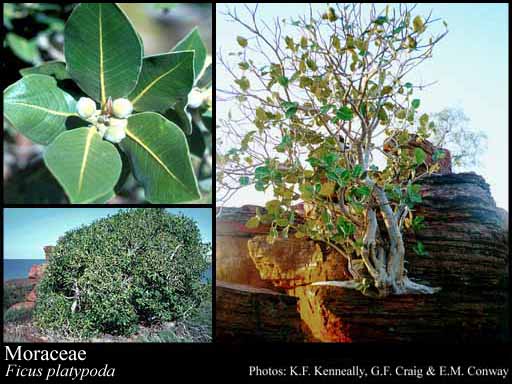- Reference
- Gen.Pl. p13 (1835)
- Name Status
- Current

Scientific Description
Common name. Mulberry Family.
Habit and leaf form. Trees, or shrubs, or lianas (including ‘stranglers’), or herbs (a few); evergreen; laticiferous (usually), or with coloured juice (Malaisia, Fatoua); resinous, or not resinous. Perennial. Self supporting, or epiphytic, or climbing. Mesophytic. Heterophyllous, or not heterophyllous. Leaves medium-sized to large; alternate, or opposite; when alternate, spiral, or distichous; leathery, or ‘herbaceous’; petiolate; non-sheathing; simple; epulvinate. Leaf blades dissected, or entire; when dissected, pinnatifid, or palmately lobed; pinnately veined, or palmately veined; cross-venulate. Leaves variously with stipules. Stipules interpetiolar, or intrapetiolar; free of one another, or concrescent; ochreate, or not ochreate; sometimes minute; caducous (often), or persistent. Leaves without a persistent basal meristem. Domatia recorded (2 genera); represented by pockets, or hair tufts. Leaf anatomy. Hydathodes present (occasionally), or absent. Stem anatomy. Nodes tri-lacunar, or penta-lacunar. Secondary thickening developing from a conventional cambial ring.
Reproductive type, pollination. Fertile flowers functionally male and functionally female, or functionally male, or functionally female. Unisexual flowers present. Plants monoecious, or dioecious. Anemophilous, or entomophilous.
Inflorescence and flower features. Flowers tightly aggregated in ‘inflorescences’, or solitary (rarely); in spikes, in heads, and in umbels (etc.). The terminal inflorescence unit cymose. Inflorescences axillary; mostly with the small flowers packed into spikes, in heads or hollowed receptacles, on disks, etc; with involucral bracts, or without involucral bracts; pseudanthial, or not pseudanthial. Flowers small (reduced); regular; cyclic. Perianth sepaline (usually), or vestigial to absent (rarely); 0 (rarely), or (1–)4–5, or 8 (rarely); 1 -whorled, or 2 -whorled; more or less joined. Calyx 4–5(–8); gamosepalous (basally connate); entire, or lobed; when not entire, lobulate, or blunt-lobed; imbricate, or valvate; regular; persistent. Fertile stamens present, or absent (female flowers). Androecium 1–3(–8) (in male flowers). Androecial members free of the perianth; free of one another. Androecium exclusively of fertile stamens. Stamens 1–4(–8); isomerous with the perianth (usually), or reduced in number relative to the adjacent perianth (10%); oppositisepalous (usually isostemonous); erect in bud (Moreae), or inflexed in bud. Anthers dehiscing via longitudinal slits (not dehiscing explosively); extrorse, or introrse; tetrasporangiate. Fertile gynoecium present, or absent (male flowers). Gynoecium in female flowers 2(–3) carpelled (1–2 usually abortive). The pistil 1(–2) celled. Carpels reduced in number relative to the perianth. Gynoecium syncarpous; synovarious to synstylovarious; superior to partly inferior. Ovary unilocular, or plurilocular; 1(–2) locular. Gynoecium stylate. Styles 2; free to partially joined; apical, or lateral. Stigmas 2; dry type; papillate, or non-papillate; Group II type. Placentation apical (usually, the ovule pendulous), or basal (rarely, the ovule then erect). Ovules in the single cavity 1; pendulous (usually), or ascending (rarely, when basal); anatropous to campylotropous, or hemianatropous.
Fruit and seed features. Fruit fleshy, or non-fleshy; indehiscent; a drupe, or achene-like; enclosed in the fleshy receptacle (often, and the inflorescence axis often constituting a common fleshy receptacle), or without fleshy investment. Gynoecia of adjoining flowers combining to form a multiple fruit (frequently), or not forming a multiple fruit. The multiple fruits coalescing (often, these sometimes explosively discharging the ‘seeds’), or not coalescing. Dispersal unit the seed, or the fruit, or the inflorescence. Fruit 1 seeded. Seeds endospermic, or non-endospermic. Endosperm oily, or not oily. Cotyledons 1 (by suppression), or 2. Embryo chlorophyllous (Streblus asper), or achlorophyllous (7/8); straight, or curved. Seedling. Germination phanerocotylar, or cryptocotylar.
Physiology, biochemistry. Aluminium accumulation not found. Photosynthetic pathway: C3.
Geography, cytology, number of species. World distribution: widespread in tropical, subtropical and warm regions. X = 7-many. 1400 species.
Economic uses, etc. Economically important for many edible ‘fruits’, e.g. figs (Ficus), mulberry (Morus), breadfruit and jackfruit (Artocarpus).